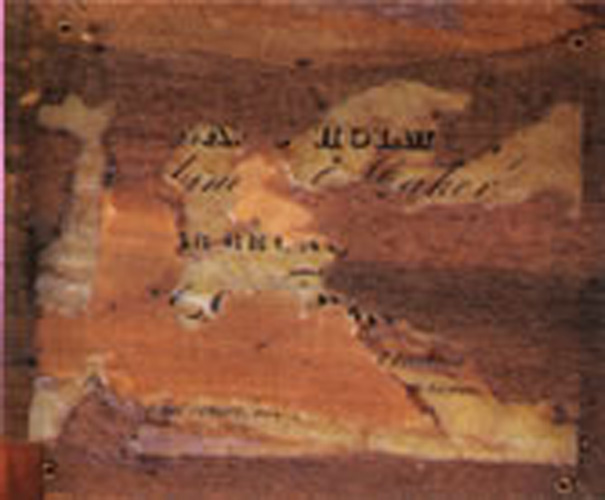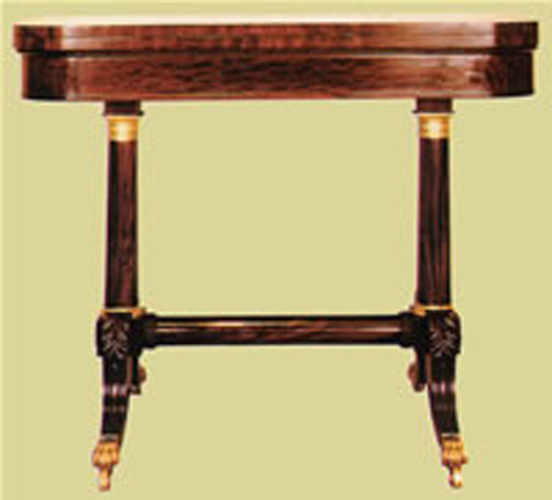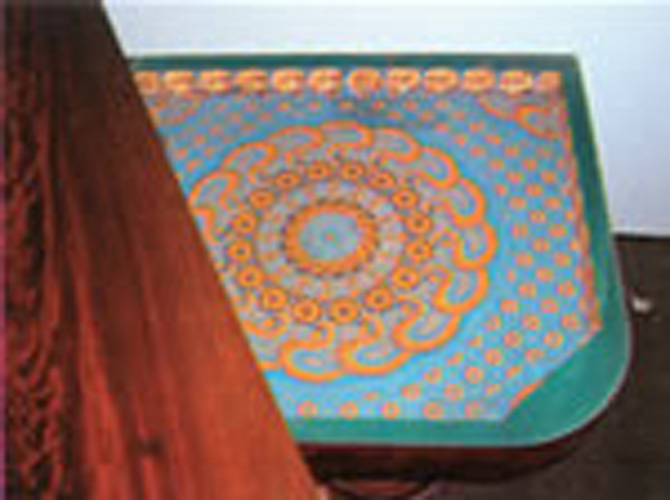
Collectors Notes
Cabinetmakers Edward Holmes and Simeon Haines revisited .
Eleanor H. Gustafson. The Magazine Antiques May 2007 pg. 76

In May 2005, Erik Rini introduced us to the work of the New York City cabinetmakers Edward Holmes and Simeon Haines, who worked alone and in partnership between 1821 and the 1840s. His article brought to light two additional pieces by these men and revealed the whereabouts of a table that had previously been un-located. Mr. Rini brings us up to date here.

Since my initial research on these craftsmen was published two years ago, two new pieces have come to my attention that provide a little more information about these artisans-their products and the market they supplied. The first is the secretary bookcase illustrated below (Fig. 1), which bears a partial label of Edward Holmes (Fig. 1a). Its significance lies primarily in the fact that it is the first example of the form to surface by either maker. It is also the only known piece bearing this specific label, which gives Holmes's address as 48 Broad Street, where he is listed as a cabinetmaker on his own in city directories between 1822 and 1824. With its columned edges, vibrant mahogany veneers, gilded stenciling, and oversized paw feet, the secretary bookcase conforms to other known examples of Empire style furniture made in New York City. However, the pediment is reminiscent of earlier Federal period secretary bookcases and is not as common on Empire case pieces, which usually have a cornice or a flat top.
The second recently discovered object is a card table (Fig. 2), which bears the chalk notations "H H'' and "no 2'' on the underside, so was presumably made by the Holmes and Haines partnership, first recorded in the city directories in 1825. Since card tables
were commonly made in pairs, the ''no 2'' in all likelihood indicates that this was the second of two. It is very similar to a card table labeled by Holmes alone and dating about 1830, which was published in my earlier article; the dimensions are virtually identical
(the fractional differences certainly attributable to the shrinkage of the wood over the years).
 The feet on this table, however, are slightly more elongated than on the Holmes table, and there is a geometric design stenciled along the base of the platform that is lacking on the Holmes table. The Holmes table is further embellished with intricately carved foliate
brackets flanking each of the front feet, and the paw design is more developed. These variances show how a cabinetmaker could enhance or modify a standard table template to fulfill the requests of specific customers. It is also worth noting that the newly discovered
Holmes and Haines card table has decorative paper lining the well beneath the swivel top (Fig. 3), a feature also found on the card table made by Holmes alone.
The feet on this table, however, are slightly more elongated than on the Holmes table, and there is a geometric design stenciled along the base of the platform that is lacking on the Holmes table. The Holmes table is further embellished with intricately carved foliate
brackets flanking each of the front feet, and the paw design is more developed. These variances show how a cabinetmaker could enhance or modify a standard table template to fulfill the requests of specific customers. It is also worth noting that the newly discovered
Holmes and Haines card table has decorative paper lining the well beneath the swivel top (Fig. 3), a feature also found on the card table made by Holmes alone.

Finally, a reader of the 2005 article informed me that he possessed the Holmes and Haines card table that was not located when I published a black-and- white photograph of it. It is reproduced here in color (Fig. 4).
This brings the total number of documented pieces produced in the Holmes and Haines shop to eight. The number by Holmes alone now stands at three. To date, there are still no known pieces made by Haines on his own.
Aileen Minor specializes in early american antiques from the 18th and 19th century. She has been offering American Classical Furniture 1790 - 1850 and garden antiques for over 30 years, with special interest in fine 19th Century lighting, glass |


